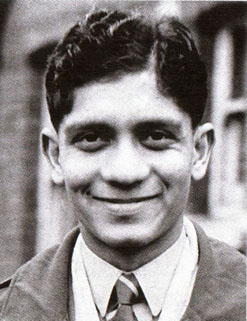Related Research Articles

Ghulam Ahmed was an off spin bowler who captained India in Test cricket. After his retirement, he served for many years as the secretary of BCCI.
Gulabrai Sipahimalani "Ram" Ramchand was an Indian cricketer, cricket coach and administrator who played for the national team in 33 Test matches between 1952 and 1960. In his only series as captain, he led India to its first win against Australia. According to Wisden Asia, he was one of the first cricketers to have endorsed commercial brands.
Michael Hugh Tissera is a former Sri Lankan cricketer who played in the 1975 Cricket World Cup.
Cricket was introduced to Sri Lanka in the first quarter of the 19th century, following colonisation of the island by the British. The earliest known match was recorded in 1832 and the earliest first-class one in 1926. The national team has played Test cricket from 1982. The national team has achieved international success by winning the 1996 Cricket World Cup and the 2014 ICC World Twenty20. Cricket is played nationwide with Test venues in Colombo, Galle, Kandy and Moratuwa. The country's most notable players include Aravinda de Silva, Arjuna Ranatunga, Rangana Herath, Sanath Jayasuriya, Mahela Jayawardene, Muttiah Muralitharan, Kumar Sangakkara and Chaminda Vaas. Administration and governance are performed by Sri Lanka Cricket, which was founded in July 1922 as the Ceylon Cricket Association (CCA). The main domestic competition is the Premier Trophy which attained first-class status in 1988.
The Indian cricket team toured England in the 1959 season. The team played five Test matches against England and lost them all: the first time that England had won all the matches in a five-match series. Only one of the Tests, the game at Manchester, went into the fifth day.

Gamini Goonesena was a Sri Lankan first-class cricketer who played prior to his country being granted Test status. A gifted allrounder who was a right-handed batsman and a legbreak and googly bowler, he played first class cricket over a 19-year timespan, 1949–1968, representing 14 different teams.
The M. J. Gopalan Trophy was an annual first-class cricket competition played between Ceylon and Madras between 1952–53 and 2007–08.

Clive Clay Inman was a Sri Lankan cricketer who played first-class cricket for Ceylon from 1956 to 1966 and for Leicestershire from 1961 to 1971.
Dr Churchill Hector Gunasekara was a Ceylonese first-class cricketer. He was the first person from his country to play for an English county, representing Middlesex from 1919 to 1922. He was widely regarded as the best fielder in county cricket at the time.
This article describes the history of cricket in Pakistan from 1947 to 1970.
The India national cricket team toured the West Indies during the 1952–53 cricket season. They played five Test matches against the West Indian cricket team, with the West Indies winning the series 1–0. India also played five other first-class matches, one of which resulted in India's victory. The tour was the first of the Caribbean by a national team other than England.
The Pakistan national cricket team toured Ceylon from mid-March to mid-April 1949 and played four matches including two internationals against the Ceylon national team. As neither country had yet achieved Test status, the internationals are classified as first-class matches. Both games were played at the Paikiasothy Saravanamuttu Stadium in Colombo and Pakistan won them both: the first by an innings and 192 runs; the second by 10 wickets. These two matches were the first four-day internationals played in Ceylon. Pakistan were captained by Mohammed Saeed and Ceylon by Derrick de Saram.
The Indian Universities cricket team played 16 three-day first-class matches, all but one against teams touring India, between October 1949 and December 1975.
The West Indies cricket team toured India from November 1958 to February 1959 and played a five-match Test series against the India national cricket team. The West Indies won the series 3–0. The West Indies were captained by Gerry Alexander while India used four different captains in the series, Ghulam Ahmed leading in two Tests.
The Ceylon cricket team toured India in December 1964 and January 1965. Ceylon did not then have Test status, but three four-day unofficial Tests were played, India winning 2–1. The tour also included five other first-class matches.
Dhansiri Weerasinghe was a cricketer who played 12 matches of first-class cricket for Ceylon between 1958 and 1969.
The Ceylon cricket team toured India in December 1932 and January 1933. Ceylon did not then have Test status, but two three-day unofficial Tests were played, both of which were drawn. The tour also included four other first-class matches and four minor matches. It was the first tour abroad by a Ceylonese team. The victories against Patiala and Central Provinces and Berar were Ceylon's first victories in first-class matches.
Edward George Samuel Kelaart was a Ceylonese cricketer who played first-class cricket between 1926 and 1935. He was Ceylon's first international captain, leading the side in two matches against India in 1932-33.
Claude van der Straaten, also spelt Vanderstaaten and Vanderstraaten was a cricketer who played on Ceylon's first tour in 1932–33.
Dayananda Sahabandu was a Sri Lankan cricketer who played first-class cricket for the Sri Lankan national team from 1968 to 1975. He was nicknamed as the "King of Viharamahadevi Park" mainly referring to his bowling heroics.
References
- ↑ "India in Ceylon 1956–57". CricketArchive. Retrieved 5 July 2014.
- ↑ Wisden 1958, pp. 897–98.
- 1 2 3 S. S. Perera, The Janashakthi Book of Sri Lanka Cricket (1832–1996), Janashakthi Insurance, Colombo, 1999, pp. 267–68.
- ↑ "Ceylon v India 1956-57 (I)". ESPNcricinfo. Retrieved 28 December 2017.
- ↑ "Central Province v Indians 1956-57" . CricketArchive. Retrieved 28 December 2017.
- ↑ "Ceylon v India 1956-57 (II)". ESPNcricinfo. Retrieved 28 December 2017.